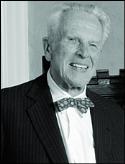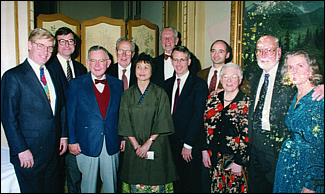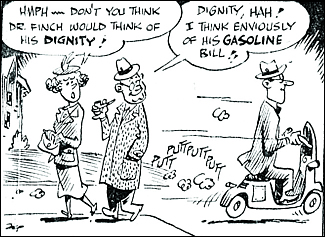Dr. Adamson is Clinical Professor at the University of California, San Diego. He is also a past president of ASH.
Clement (Clem) Alfred Finch, MD, was born on July 4, 1915, in upstate New York. With a father and grandfather who were physicians, and occasionally joining his father on evening house calls, Dr. Finch decided to follow in their footsteps. After his second year at the University of Rochester Medical School, Dr. Finch was offered the Dean's Fellowship to work with Nobel Prize winner George Whipple — a pillar at the school. Although Dr. Finch didn't feel he "accomplished anything [in] particular," his first paper, on hemoglobin regeneration in dogs that had been bled, was published in theJournal of Experimental Medicine, which was not bad for a second-year student. Also, in Rochester he came into contact with Paul Hahn, who was working on iron metabolism, and, to a lesser extent, Joe Ross, whom Dr. Finch would later join in Boston. He began to feel that academic life could be fun!
After graduating in 1941, Dr. Finch went to the Brigham in Boston, where he encountered many of the leaders in American medicine, including Soma Weiss. In those days, house officers lived in the hospital, and, if they wanted to get married, they had to ask for permission! Dr. Finch married after one year. Dr. Weiss said, "Congratulations, but when you come back, act like you're not married." Dr. Finch felt that when he was at the Brigham the most important thing in his life was being a good clinician. The Brigham spirit was one of viewing each patient as a research subject. Patient loads were light; inquiry was fostered. There was ample contact with stellar physicians, such as Eugene Stead and Charlie Janeway.
A group photo taken at a reception honoring Dr. Finch at the 1995 annual meeting in Seattle. From left to right: Drs. Michael Miller, John Adamson, Charlie Rath, Dan Coleman, Eugenia Finch, Clem Finch, John Harlan, Yves Beguin, Elo Giblett, E. Donnall Thomas, and Dottie Thomas.
A group photo taken at a reception honoring Dr. Finch at the 1995 annual meeting in Seattle. From left to right: Drs. Michael Miller, John Adamson, Charlie Rath, Dan Coleman, Eugenia Finch, Clem Finch, John Harlan, Yves Beguin, Elo Giblett, E. Donnall Thomas, and Dottie Thomas.
After his clinical training, Dr. Finch accepted a fellowship with Joe Ross at Boston University. It was Dr. Ross who really introduced Dr. Finch to academic medicine, taking him on trips to Washington, DC, for meetings of the National Research Council (NRC). With Dr. Ross, the work in iron metabolism and blood preservation began in earnest. Dr. Finch's contributions to blood preservation are often overlooked, but it was a very important issue at that time with the nation at war.
At the end of the year, George Thorn brought Dr. Finch back to the Brigham as Chief Resident, made him director of the nascent hematology labs, and gave him some lab space of his own. Eventually, Dr. Finch became responsible for blood transfusion therapy at the Brigham.
This was also a time of gathering for those interested in iron: Charlie Rath, cousin Stu Finch, Robly Evans, and Don Haskins. The Finches and Haskins began to look at bleeding as a way to treat hemochromatosis. Boston was rich in hematology.
Dr. Finch around the time he joined the faculty at the University of Washington.
Dr. Finch around the time he joined the faculty at the University of Washington.
By 1948, Dr. Finch felt it was time to go. Having grown up in the Adirondacks and loving the outdoors, Dr. Finch always thought of moving to a place with mountains. In 1948, he was invited by Bob Williams, the new Chair of Medicine in Seattle, to look at a position there. John Lawrence (from Rochester) tried to recruit Dr. Finch to the UCLA faculty but Dr. Finch decided on Seattle, where he could build a new division from scratch in his own vision of an integrated clinical, teaching, and research-oriented division. LA was smoggy; Seattle was clean and fresh, according to Dr. Finch. Seattle was a new medical school; it opened in 1946. With Dr. Finch's spirit of adventure, three technicians also made the move across the country with him. This was a testament to Dr. Finch's belief that a core of loyal technicians is key to a lab's success.
While studies of iron metabolism became the backbone of his research, the first 10 years in Seattle were also marked by continuing efforts to increase the storage life of red cells for transfusion. Ernie Simon and Beverly Gabrio led these efforts and they realized that as ATP in storage declined over time, red cells became less viable. The work on blood preservation was carried out in labs at the King County Blood Bank (now Puget Sound Blood Center). The exposure to the workings and people who were on the NRC contributed greatly to Dr. Finch's interest in this particular field.
The work on iron advanced. Dr. Finch's lab established the principles of red-cell production and internal iron metabolism. This formed the basis of a physiological classification of anemia and polycythemia, resulting in the "Red Cell Manual," a book designed for medical students. The principles remain as valid today as they were 40 years ago and reflect Dr. Finch's abiding interests in physiology and education.
A cartoon from the UW student newspaper lampooning Dr. Finch's habit of driving about town on a tiny Vespa. Cartoon reprinted with permission from The Daily of the University of Washington.
A cartoon from the UW student newspaper lampooning Dr. Finch's habit of driving about town on a tiny Vespa. Cartoon reprinted with permission from The Daily of the University of Washington.
Much work was done to understand how iron was absorbed and how it trafficked. This literally set the table for the revolution in understanding provided by molecular biology. Dr. Finch recognized the "erythropoietic regulator" and the "iron stores regulator," and provided the criteria used today to define iron deficiency and iron-deficient erythropoiesis. Work on iron absorption was valuable in assisting the World Health Organization to be able to make recommendations concerning diets in developing countries. Dr. Finch came to view anemia and iron in the context of the nutritional status of a population. For his studies on iron, he was elected to the National Academy of Sciences.
In 1966, Dr. Finch served as the eighth president of ASH. The clinicians in the society were becoming restive because the annual meeting program was considered irrelevant to the needs of the practitioner. From those discussions emerged the format of the annual meeting as we have it today — the first two days devoted to Education Sessions, admixed with the programs of the Scientific Committees, and the very useful ASH Education Book.
Dr. Finch lived life a bit differently. He loved the outdoors and climbing in the Cascades. He put his skills to the test one day when, having forgotten his keys, he scaled the outside of the Health Sciences Building to get into his office. Occasionally, on his forays into the woods, he would bring back mushrooms — as John Huff, a young faculty person at Harborview, discovered when he went to take a preparation of tobacco mosaic virus off the lyophilyzer only to find that Dr. Finch was drying mushrooms!
At six feet, five inches, Dr. Finch was conspicuous going between hospitals on his Vespa. In an attempt to carve out more hours for his science, Dr. Finch worked all night, every other night. The reduced-sleeping routine lasted for about a week. And, he may be the only faculty person at the University of Washington targeted by the Medical Executive Committee, who ruled that hospital rounds were not to be made wearing lederhosen.
As I look back on my time with Dr. Finch in Seattle, anything was possible intellectually. There was a wonderful faculty doing truly meaningful clinical research and a hematology program built on rigor and collaboration. Not a bad model.
ASH Extends Its Thanks
Drs. Frank Bunn, Marshall Lichtman, and Wendell Rosse graciously agreed to coordinate with The Hematologist to present the 50th anniversary profiles starting in late 2007 through the end of our anniversary year. We would like to say thank you to Drs. Bunn, Lichtman, and Rosse for all their exemplary work. They put forth their time and effort to give readers the opportunity to learn more about these extraordinary individuals. Because of the quality and popularity of these articles, we will be extending this series into 2009. All of the Legends in Hematologyprofiles are available online.





